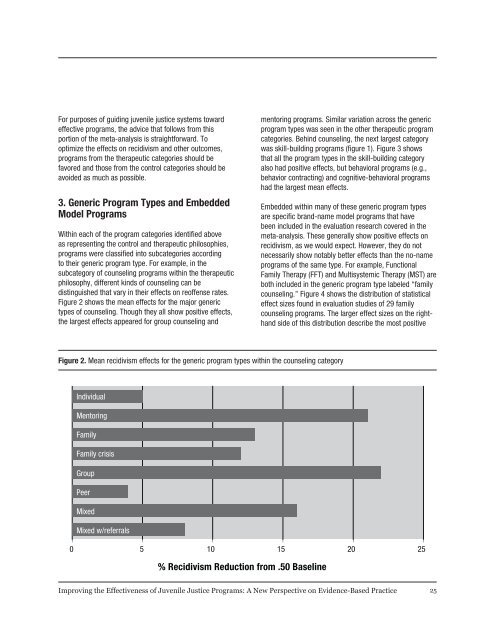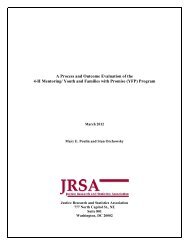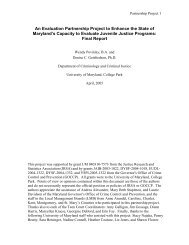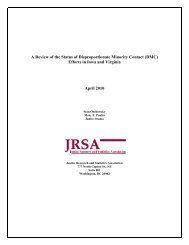Improving the Effectiveness of Juvenile Justice Programs: A New
Improving the Effectiveness of Juvenile Justice Programs: A New
Improving the Effectiveness of Juvenile Justice Programs: A New
Create successful ePaper yourself
Turn your PDF publications into a flip-book with our unique Google optimized e-Paper software.
For purposes <strong>of</strong> guiding juvenile justice systems toward<br />
effective programs, <strong>the</strong> advice that follows from this<br />
portion <strong>of</strong> <strong>the</strong> meta-analysis is straightforward. To<br />
optimize <strong>the</strong> effects on recidivism and o<strong>the</strong>r outcomes,<br />
programs from <strong>the</strong> <strong>the</strong>rapeutic categories should be<br />
favored and those from <strong>the</strong> control categories should be<br />
avoided as much as possible.<br />
3. Generic Program Types and Embedded<br />
Model <strong>Programs</strong><br />
Within each <strong>of</strong> <strong>the</strong> program categories identified above<br />
as representing <strong>the</strong> control and <strong>the</strong>rapeutic philosophies,<br />
programs were classified into subcategories according<br />
to <strong>the</strong>ir generic program type. For example, in <strong>the</strong><br />
subcategory <strong>of</strong> counseling programs within <strong>the</strong> <strong>the</strong>rapeutic<br />
philosophy, different kinds <strong>of</strong> counseling can be<br />
distinguished that vary in <strong>the</strong>ir effects on re<strong>of</strong>fense rates.<br />
Figure 2 shows <strong>the</strong> mean effects for <strong>the</strong> major generic<br />
types <strong>of</strong> counseling. Though <strong>the</strong>y all show positive effects,<br />
<strong>the</strong> largest effects appeared for group counseling and<br />
mentoring programs. Similar variation across <strong>the</strong> generic<br />
program types was seen in <strong>the</strong> o<strong>the</strong>r <strong>the</strong>rapeutic program<br />
categories. Behind counseling, <strong>the</strong> next largest category<br />
was skill-building programs (figure 1). Figure 3 shows<br />
that all <strong>the</strong> program types in <strong>the</strong> skill-building category<br />
also had positive effects, but behavioral programs (e.g.,<br />
behavior contracting) and cognitive-behavioral programs<br />
had <strong>the</strong> largest mean effects.<br />
Embedded within many <strong>of</strong> <strong>the</strong>se generic program types<br />
are specific brand-name model programs that have<br />
been included in <strong>the</strong> evaluation research covered in <strong>the</strong><br />
meta-analysis. These generally show positive effects on<br />
recidivism, as we would expect. However, <strong>the</strong>y do not<br />
necessarily show notably better effects than <strong>the</strong> no-name<br />
programs <strong>of</strong> <strong>the</strong> same type. For example, Functional<br />
Family Therapy (FFT) and Multisystemic Therapy (MST) are<br />
both included in <strong>the</strong> generic program type labeled “family<br />
counseling.” Figure 4 shows <strong>the</strong> distribution <strong>of</strong> statistical<br />
effect sizes found in evaluation studies <strong>of</strong> 29 family<br />
counseling programs. The larger effect sizes on <strong>the</strong> righthand<br />
side <strong>of</strong> this distribution describe <strong>the</strong> most positive<br />
Figure 2. Mean recidivism effects for <strong>the</strong> generic program types within <strong>the</strong> counseling category<br />
Individual<br />
Mentoring<br />
Family<br />
Family crisis<br />
Group<br />
Peer<br />
Mixed<br />
Mixed w/referrals<br />
0 5 10 15 20 25<br />
% Recidivism Reduction from .50 Baseline<br />
<strong>Improving</strong> <strong>the</strong> <strong>Effectiveness</strong> <strong>of</strong> <strong>Juvenile</strong> <strong>Justice</strong> <strong>Programs</strong>: A <strong>New</strong> Perspective on Evidence-Based Practice<br />
25

















